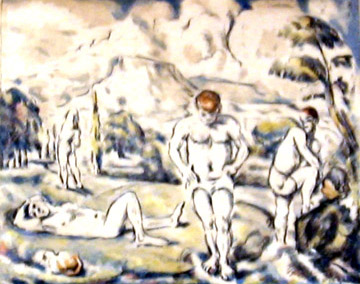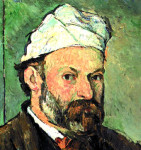
Paul Cézanne
French, 1839-1906
The Large Bathers (Les Baigneurs), 1898 ca., later print
lithograph, 21/120
16 3/4 x 20 3/4 in.
SBMA, Gift of Dr. and Mrs. MacKinley Helm
1955.20.1

Cezanne self-portrait n.d.
"I want to make Impressionism something solid and lasting like the art in the museums." - Paul Cézanne
RESEARCH PAPER
This color lithograph by Paul Cezanne in our collection is from one of only three he prepared in his lifetime. Printmaking was not of interest to him, however, his close association with Vollard who was involved in the Print Revival of the nineties, coaxed him into the process. This lithograph was made in 1895 but was probably printed posthumously about 1914. It is a very fine impression on laid paper with the watermark MBM. The colors ocher, blue, green, yellow and red have the transparancy as in a watercolor correspond to Druick's 3rd state. It was prepared with brush, tusche and crayon.
Studies for the composition of groups o£ male and female bathers seen on the banks of a river occupied him since the 70's. Male bathers are partly inspired by recollections of his youth when he would swim in the Arc River in the valley below Mt. St. Victoire, and expression mentioned in several poems and letters to his boyhood friend, Emile Zola. Only in later years did female bathers take precedence. Groups of male bathers are conceived in energetic and varied rhythm while females are generally more monumental in their grouping, their bodies relaxed.
Cezanne's early work (1860's), painted with brutal power, depicted violent expressions of his dark imagination. They were products of anxieties springing from the heavy hand of his father, and his own despair of realizing his dreams. They were actually images, which harken back to Goya and heralded the work of de Kooning.
These early expressions were abandoned in his Impressionist phase, which began in 1872. His visits to Auvers and Pontaise led to a close association with Pissaro. With Pissaro, he learned to relate his painting more to the evidence of his eyes and to register what he saw by means of short, separate strokes of color.
Cezanne gradually turned away from Impressionism. He realized that a mere record of the play of light and the atmosphere of landscape would not satisfy him. He needed a method that would bring all the elements of painting as he conceived it, into close accord. His vision reconstructed and reconciled form with color, object with light, and at a deeper level, imagination with observation. He rejected conventional vision. He had no qualms about taking liberties with perspective as is evidenced in his still lifes.
Cezanne's unique style shows the mind of a sculptor who expressed himself through painting. Even though he never undertook a sculpture, there's no denying he had the sculptor's feeling for mass-weight. He was known to say, "Only mass counts." His birth in 1839 shortly before the technical, industial and scientific revolution could explain, in a confusing way, his obsession with mass-weight to express this power which man was beginning to aquire. Spending most of his life in Aix-en-Provence, where he was born and died, near the Mediterranean, light was so bright it effaced color, making volume seem more real. For him, volume was the touch-stone of reality. In order for him to achieve this effect, he built his shapes through relentless parallel hatches of paint. Blunt, geometric form emerge like steel girders beneath organic rhythms of the natural world which give the visceral sense of stable durability. He linked classical structure with contemporary realism.
During his lifetime and even immediately after his death, he was still thought by some to be a strange, minor figure attached to the Impressionist movement of forty years before. The true measure of his genius was only gradually recognized as people saw how immensely indebted to him were the painters who came to prominence just before the 1st World War grouped about the figures of Picasso, Braque, Derain and Matisse. He offered these artists, the Fauves and the Cubists, abundant possibilities. His death in 1906 came one year before the appearance of Fauvism, two years before that of Cubism and four years before the first abstract painting. It is understandable that he is referred to as the "Father of Modern Painting." Cezanne lived most of his life in the 19th century but seems to belong to this century.
Prepared for the Santa Barbara Museum of Art Docent Council by Joan Mc Cullough April 14, 1993
BIBLIOGRAPHY
Shone, Richard. The Post-Impressionists, New York, John Colman and Cooper, Ltd., 1979.
Jalard, Michel-Claude. Post Impressionism. Paris, Editions Rencontre Lausanne, 1966.
Barskaya, Anna. Paul Cezanne. Leningrad, Aurora Art Press, 1983.
Taillandier, Yvon. P. Cezanne. New York, Crown Publishers, Inc.,1961.
Johnson, Ellen H. The Great Artists-Cezanne Book 18. New York, Funk and Wagnalls, 1977.
Kendall, Richard. The History and Techniques of the Great Masters. Seacaucus, New Jersey, Chartwell Books, 1989.
Halpern, Daniel. Writers on Artists. San Francisco, North Point Press, 1988.
Bulletin, National Gallery of Canada, Ottawa
